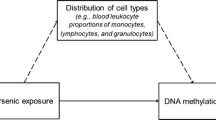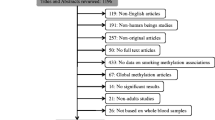Abstract
Inorganic arsenic is methylated in the body by arsenic (III) methyltransferase (AS3MT). Arsenic methylation is thought to play a role in arsenic-related epigenetic phenomena, including aberrant DNA and histone methylation. However, it is unclear whether the promoter of the AS3MT gene, which codes for AS3MT, is differentially methylated as a function of arsenic exposure. In this study, we evaluated AS3MT promoter methylation according to exposure, assessed by urinary arsenic excretion in a stratified random sample of 48 participants from the Strong Heart Study who had urine arsenic measured at baseline and DNA available from 1989 to 1991 and 1998–1999. For this study, all data are from the 1989–1991 visit. We measured AS3MT promoter methylation at its 48 CpG loci by bisulphite sequencing. We compared mean % methylation at each CpG locus by arsenic exposure group using linear regression adjusted for study centre, age and sex. A hypomethylated region in the AS3MT promoter was associated with higher arsenic exposure. In vitro, arsenic induced AS3MT promoter hypomethylation, and it increased AS3MT expression in human peripheral blood mononuclear cells. These findings may suggest that arsenic exposure influences the epigenetic regulation of a major arsenic metabolism gene.

Similar content being viewed by others
References
Agusa T et al (2010) Exposure, metabolism, and health effects of arsenic in residents from arsenic-contaminated groundwater areas of Vietnam and Cambodia: a review. Rev Environ Health 25:193–220
Agusa T et al (2011) Individual variations in inorganic arsenic metabolism associated with AS3MT genetic polymorphisms. Int J Mol Sci 12:2351–2382
Arita A, Costa M (2009) Epigenetics in metal carcinogenesis: nickel, arsenic, chromium and cadmium. Metallomics 1:222–228
Baccarelli A, Bollati V (2009) Epigenetics and environmental chemicals. Curr Opin Pediatr 21:243–251
Baccarelli A et al (2010) Ischemic heart disease and stroke in relation to blood DNA methylation. Epidemiology 21:819–828
Bailey KA et al (2013) Arsenic and the epigenome: interindividual differences in arsenic metabolism related to distinct patterns of DNA methylation. J Biochem Mol Toxicol 27:106–115
Benbrahim-Tallaa L et al (2005) Molecular events associated with arsenic-induced malignant transformation of human prostatic epithelial cells: aberrant genomic DNA methylation and K-ras oncogene activation. Toxicol Appl Pharmacol 206:288–298
Buchet JP et al (1981) Comparison of the urinary excretion of arsenic metabolites after a single oral dose of sodium arsenite, monomethylarsonate, or dimethylarsinate in man. Int Arch Occup Environ Health 48:71–79
Chen CJ et al (1996) Dose-response relationship between ischemic heart disease mortality and long-term arsenic exposure. Arterioscler Thromb Vasc Biol 16:504–510
Chen YC et al (2003) Arsenic methylation and skin cancer risk in southwestern Taiwan. J Occup Environ Med 45:241–248
Chen H et al (2004) Chronic inorganic arsenic exposure induces hepatic global and individual gene hypomethylation: implications for arsenic hepatocarcinogenesis. Carcinogenesis 25:1779–1786
Chen B et al (2011) Mouse arsenic (+3 oxidation state) methyltransferase genotype affects metabolism and tissue dosimetry of arsenicals after arsenite administration in drinking water. Toxicol Sci 124:320–326
Cui X et al (2006) Arsenic trioxide inhibits DNA methyltransferase and restores methylation-silenced genes in human liver cancer cells. Hum Pathol 37:298–311
Del Razo LM et al (2011) Exposure to arsenic in drinking water is associated with increased prevalence of diabetes: a cross-sectional study in the Zimapan and Lagunera regions in Mexico. Environ Health 10:73
DiCiccio TJ, Efron B (1996) Bootstrap confidence intervals. Stat Sci 11:189–212
Drobna Z et al (2006) shRNA silencing of AS3MT expression minimizes arsenic methylation capacity of HepG2 cells. Chem Res Toxicol 19:894–898
Drobna Z et al (2009) Disruption of the arsenic (+3 oxidation state) methyltransferase gene in the mouse alters the phenotype for methylation of arsenic and affects distribution and retention of orally administered arsenate. Chem Res Toxicol 22:1713–1720
Drobna Z et al (2010) Interspecies differences in metabolism of arsenic by cultured primary hepatocytes. Toxicol Appl Pharmacol 245:47–56
Engström K, et al (2010) Polymorphisms in arsenic(+III Oxidation State) methyltransferase (AS3MT) predict gene expression of AS3MT as well as arsenic metabolism. Environ Health Perspect 119
Engstrom K et al (2011) Polymorphisms in arsenic(+III oxidation state) methyltransferase (AS3MT) predict gene expression of AS3MT as well as arsenic metabolism. Environ Health Perspect 119:182–188
Engström KS, Hossain MB, Lauss M, Ahmed S, Raqib R et al (2013) Efficient arsenic metabolism—the AS3MT haplotype is associated with DNA methylation and expression of multiple genes around AS3MT. PLoS ONE 8(1):e53732. doi:10.1371/journal.pone.0053732
Fujihara J et al (2008) Asian specific low mutation frequencies of the M287T polymorphism in the human arsenic (+3 oxidation state) methyltransferase (AS3MT) gene. Mutat Res 654:158–161
Fujihara J et al (2009) Ethnic differences in five intronic polymorphisms associated with arsenic metabolism within human arsenic (+3 oxidation state) methyltransferase (AS3MT) gene. Toxicol Appl Pharmacol 234:41–46
Fujihara J et al (2010) Global analysis of genetic variation in human arsenic (+3 oxidation state) methyltransferase (AS3MT). Toxicol Appl Pharmacol 243:292–299
Fujihara J et al (2011) Genetic variants associated with arsenic metabolism within human arsenic (+3 oxidation state) methyltransferase show wide variation across multiple populations. Arch Toxicol 85:119–125
Gribble MO et al (2012) Arsenic exposure, diabetes prevalence, and diabetes control in the strong heart study. Am J Epidemiol 176:865–874
Hall M et al (2007) Determinants of arsenic metabolism: blood arsenic metabolites, plasma folate, cobalamin, and homocysteine concentrations in maternal-newborn pairs. Environ Health Perspect 115:1503–1509
Hou L et al (2012) Environmental chemical exposures and human epigenetics. Int J Epidemiol 41:79–105
Huang YK et al (2008) Arsenic exposure, urinary arsenic speciation, and the incidence of urothelial carcinoma: a twelve-year follow-up study. Cancer Causes Control 19:829–839
Huang YL et al (2009) Urinary arsenic methylation capability and carotid atherosclerosis risk in subjects living in arsenicosis-hyperendemic areas in southwestern Taiwan. Sci Total Environ 407:2608–2614
IARC (2004) Some drinking-water disinfectants and contaminants, including Arsenic. IARC monographs on the evaluation of carcinogenic risks to humans, Vol. 84, Lyon, France
Jensen TJ et al (2009) Arsenicals produce stable progressive changes in DNA methylation patterns that are linked to malignant transformation of immortalized urothelial cells. Toxicol Appl Pharmacol 241:221–229
Jomova K et al (2011) Arsenic: toxicity, oxidative stress and human disease. J Appl Toxicol 31:95–107
Jutooru I et al (2010) Arsenic trioxide downregulates specificity protein (Sp) transcription factors and inhibits bladder cancer cell and tumor growth. Exp Cell Res 316:2174–2188
Kala SV et al (2004) Formation and urinary excretion of arsenic triglutathione and methylarsenic diglutathione. Chem Res Toxicol 17:243–249
Lee ET et al (1990) The strong heart study. A study of cardiovascular disease in American Indians: design and methods. Am J Epidemiol 132:1141–1155
Lin L et al (2005) Arsenite induces a cell stress-response gene, RTP801, through reactive oxygen species and transcription factors Elk-1 and CCAAT/enhancer-binding protein. Biochem J 392:93–102
Lindberg AL et al (2008) The risk of arsenic induced skin lesions in Bangladeshi men and women is affected by arsenic metabolism and the age at first exposure. Toxicol Appl Pharmacol 230:9–16
Lu G et al (2001) Effects of inorganic arsenicals on the methylation of p16 gene CpG islands and the expression of p16 gene in BEP2D cells. Zhonghua Yi Xue Za Zhi 81:1238–1241
Marsit CJ et al (2006) Carcinogen exposure and gene promoter hypermethylation in bladder cancer. Carcinogenesis 27:112–116
Martinez-Zamudio R, Ha HC (2011) Environmental epigenetics in metal exposure. Epigenetics 6:820–827
Mass MJ, Wang L (1997) Arsenic alters cytosine methylation patterns of the promoter of the tumor suppressor gene p53 in human lung cells: a model for a mechanism of carcinogenesis. Mutat Res 386:263–277
Navas-Acien A et al (2006) Arsenic exposure and type 2 diabetes: a systematic review of the experimental and epidemiological evidence. Environ Health Perspect 114:641–648
Navas-Acien A et al (2008) Arsenic exposure and prevalence of type 2 diabetes in US adults. JAMA 300:814–822
Navas-Acien A et al (2009) Urine arsenic concentrations and species excretion patterns in American Indian communities over a 10-year period: the strong heart study. Environ Health Perspect 117:1428–1433
North KE et al (2003) Genetic and environmental contributions to cardiovascular disease risk in American Indians: the strong heart family study. Am J Epidemiol 157:303–314
Okoji RS et al (2002) Sodium arsenite administration via drinking water increases genome-wide and Ha-ras DNA hypomethylation in methyl-deficient C57BL/6 J mice. Carcinogenesis 23:777–785
Reichard JF, Puga A (2010) Effects of arsenic exposure on DNA methylation and epigenetic gene regulation. Epigenomics 2:87–104
Reichard JF et al (2007) Long term low-dose arsenic exposure induces loss of DNA methylation. Biochem Biophys Res Commun 352:188–192
Scheer J, Goessler W, Francesconi KA, Howard B, Umans JH, Pollak J, Tellez-Plaza M, Silbergeld EK, Guallar E, Navas-Acien A (2012) Arsenic species and selected metals in human urine: validation of HPLC/ICPMS and ICPMS procedures for a long-term population-based epidemiological study. Anal Methods 4:406–413
Seow WJ et al (2012) Urinary benzene biomarkers and DNA methylation in Bulgarian petrochemical workers: study findings and comparison of linear and beta regression models. PLoS ONE 7:e50471
States JC et al (2009) Arsenic and cardiovascular disease. Toxicol Sci 107:312–323
Stuart EA, Hanna DB (2013) Should epidemiologists be more sensitive to design sensitivity? Epidemiology 24:88–89
Styblo M et al (2002) The role of biomethylation in toxicity and carcinogenicity of arsenic: a research update. Environ Health Perspect 110(Suppl 5):767–771
Thomas DJ (2009) Unraveling arsenic-glutathione connections. Toxicol Sci 107:309–311
Thomas DJ et al (2007) Arsenic (+3 oxidation state) methyltransferase and the methylation of arsenicals. Exp Biol Med (Maywood) 232:3–13
Toperoff G et al (2012) Genome-wide survey reveals predisposing diabetes type 2-related DNA methylation variations in human peripheral blood. Hum Mol Genet 21:371–383
Vahter M, Concha G (2001) Role of metabolism in arsenic toxicity. Pharmacol Toxicol 89:1–5
Wang JP et al (2002) A review of animal models for the study of arsenic carcinogenesis. Toxicol Lett 133:17–31
Weisenberger DJ et al (2006) CpG island methylator phenotype underlies sporadic microsatellite instability and is tightly associated with BRAF mutation in colorectal cancer. Nat Genet 38:787–793
Wong ML, Medrano JF (2005) Real-time PCR for mRNA quantitation. Biotechniques 39:75–85
Wood TC et al (2006) Human arsenic methyltransferase (AS3MT) pharmacogenetics: gene resequencing and functional genomics studies. J Biol Chem 281:7364–7373
Yamamoto M et al (2008) Selective activation of NF-kappaB and E2F by low concentration of arsenite in U937 human monocytic leukemia cells. J Biochem Mol Toxicol 22:136–146
Yao X et al (2008) Inhibition of interleukin-13 gene expression in T cells through GATA-3 pathway by arsenic trioxide. Chin Med J (Engl) 121:2346–2349
Zubizarreta JR et al (2013) Effect of the 2010 Chilean earthquake on posttraumatic stress: reducing sensitivity to unmeasured bias through study design. Epidemiology 24:79–87
Acknowledgments
Supported by grants from the National Heart Lung and Blood Institute (R01HL090863 and by Strong Heart Study grants HL41642, HL41652, HL41654 and HL65520) and the National Institute of Environmental Health Sciences (R01ES021367, R00ES016817 and P30ES03819). M. Gribble was supported by T32 training grants from the National Heart, Lung, and Blood Institute (5T32HL007024) and the National Institute of Diabetes and Digestive and Kidney Diseases (5T32DK062707-10).
Author information
Authors and Affiliations
Corresponding author
Electronic supplementary material
The supplemental materials illustrate the raw data used to generate individual % methylation variables at each CpG locus (Supplement 1), the distribution of % methylation values across individuals at each CpG locus (Supplement 2) and mean level of % DNA methylation in a 30-CpG-loci region of the AS3MT promoter (Supplement 3).
Below is the link to the electronic supplementary material.
Rights and permissions
About this article
Cite this article
Gribble, M.O., Tang, Wy., Shang, Y. et al. Differential methylation of the arsenic (III) methyltransferase promoter according to arsenic exposure. Arch Toxicol 88, 275–282 (2014). https://doi.org/10.1007/s00204-013-1146-x
Received:
Accepted:
Published:
Issue Date:
DOI: https://doi.org/10.1007/s00204-013-1146-x




